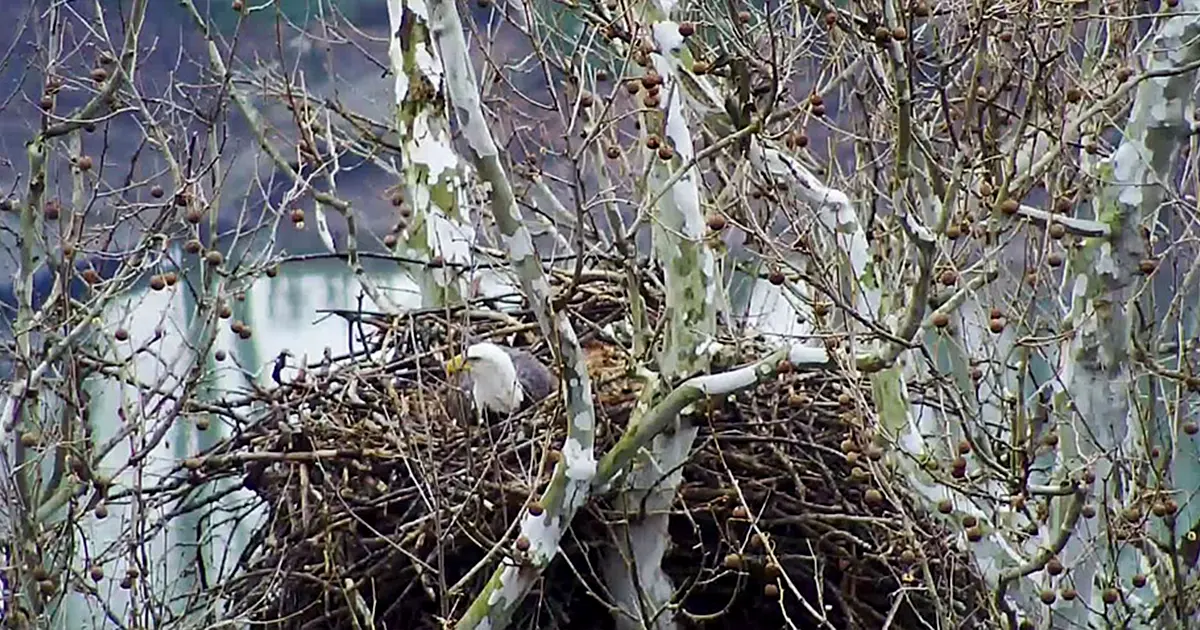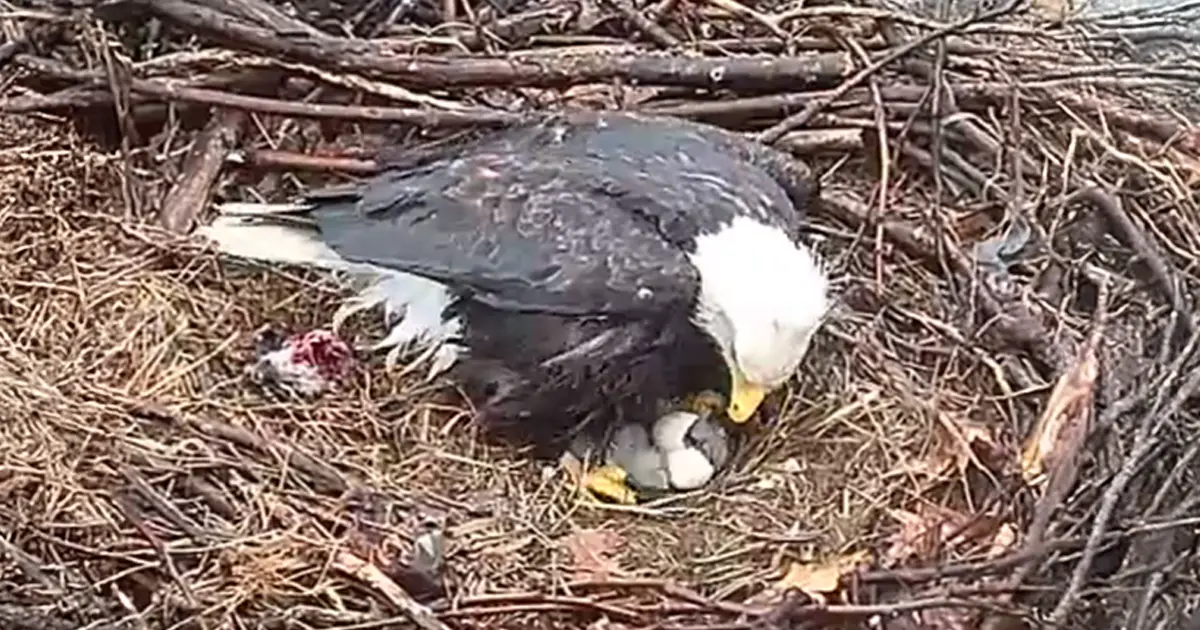Bald Eagles at Home in Pittsburgh
When Bald Eagles began nesting in the City of Pittsburgh in 2013, it marked the first time in nearly 100 years that the birds had made their presence known in our city. Over 10 years later, viewing the nests has become an adventure for new and established birders alike. Webcams and eager eagle fans have watched via webcams as eggs were laid, eaglets hatched, and fledged the nest. There were also difficult times including downed trees, destroyed nests, and unviable eggs.
The return of nesting eagles marked a positive milestone for local ecosystem health—successful Bald Eagles rely upon clean water and a hospitable environment. It’s great news for both birds and people!
Hays Nest
Bald Eagle Nest in Hays, PA – City of Pittsburgh
In 2025, the Hays Bald Eagles did not rebuild a nest in sight of the web cam.
In 2024, Audubon Society of Western Pennsylvania worked in partnership with PixCams to live stream this area, located in Hays (City of Pittsburgh), PA. Additional thanks to our partners, Davey Tree, Duquesne Light Company, and US Steel. The cam was pointed at the Bald Eagles nest, which had been located in the visible tree. In August of 2024, the nest collapsed. At this time, we do not know if or where the Hays Bald Eagles will choose to rebuild.
Hays Nest timeline

Hamar Nest
Bald Eagle Nest in Harmar, PA – the hillside above Route 28.
In 2025, the Harmar Bald Eagles did not lay eggs in their nest. There is no cam on the nest, so this information was gained from observations (no parents staying on the nest at all times for incubation).
Audubon had the opportunity to purchase this property—preserving it and protecting it from any future development. This will allow the Harmar Eagles to continue using the site for nesting and growing their family.
Hamar Nest timeline
Bald Eagle FAQ
Learn more about Pittsburgh’s Bald Eagles
How long do Bald Eagles live?
Eagles have lived in captivity for 48 years under ideal conditions; in the wild, this age may be cut in half. Research shows that only 50% of eaglets will survive their first year, and only 1 in 10 will live to the age of 5 (adulthood). Once they reach this age, most will live to be 20 years old on average.
How big are Bald Eagles?
Adult-sized eagles, depending on sex and age, will have a wingspan of 6-7 feet. Females have larger wingspans than males and weigh approximately 20% more. First year birds have larger wingspans than older birds of the same sex because of their longer “practice” feathers, which make learning to fly easier. Eagles will weigh between 8-12 lbs. with a body length of about 32”.
How big is a Bald Eagle nest?
Nests are refurbished each spring before the eggs are laid, but other material may be added after eggs are laid and even when the chicks are still in the nest. Nests therefore grow through the years. Most nests are about four feet wide and three feet or more deep. Unlike many birds, eagles’ nests are often flat at the top – not containing the typical “cup” shape. A typical nest weighs hundreds of pounds – some record nests have weighed over 2000 pounds!! Nests can get so large that they often bring down the tree they are built in.
When do the Bald Eagles lay their eggs?
Eagles in this part of the country tend to lay their eggs sometime around early March. Each pair is different, and the timing likely depends upon many factors which may include snow/ice cover, food availability, and their own hormone levels.
What does a Bald Eagle egg look like?
Eagles lay white, oval shaped eggs. The eggs weigh approximately 125 grams or 4.4 ounces, and are on average about 2.9 inches long and 2.2 inches wide. Size-wise, they are just a tad smaller than a tennis ball, though oval.
How many days are there between eggs being laid?
The average time between egg laying can range from 2-4 days, and the eaglets will hatch out that many days apart if all goes well.
How many eggs does a female Bald Eagle lay per season?
The number of eggs can be from one to four, but two is the most common. Some research says that 79% of all nests contain two eggs.
How long do the parent eagles incubate the eggs?
Typically about 35 days after each egg has been laid. The adults will begin incubating as soon as the first egg is laid. Sometimes eggs may be laid two days or more apart, resulting in one chick being the dominant chick of the hatch. The female typically does the majority of incubation, though the male also spends time incubating. Both birds develop brood patches (a bare part of the chest which makes contact with the eggs), but the female typically has a more extensive brood patch.
Can you tell which Bald Eagle is the male and which is the female?
While eagles can weigh 7 – 17 lbs., the females weight about 20% more than the males. The females in this region typically weigh about 10-12 lbs. Aside from the size difference, during incubation, the female typically spends much more time on the nest than the male.
How long will eaglets stay in their nest?
Several weeks actually. Eaglets will grow rapidly over a short amount of time and soon be the same size as the parents. In Pennsylvania, they will leave the nest typically during mid-summer and return to the nest until they finally are forced by their parents to move away.
Why aren’t the parent eagles incubating the eggs?
Everyone knows that eggs shouldn’t get too cold, but they also can’t get too hot, or the embryos will die. The adults sit on the eggs when they need heat and get off of them when they need to be cooled. In particular, eagles in PA lay eggs and care for nestlings in late winter and early spring, so their challenges include snow storms, ice, and rain. These things can be frightening to us, but eagles have been coping with them for tens of thousands of years. It is okay for the adults to spend some time off their eggs.
The adult eagles also turn their eggs regularly. Turning the eggs helps to keep them all at the same temperature.
What do Bald Eagles eat?
Eagles will mainly eat fish, but will also hunt for food such as rabbits, squirrels, snakes, frogs, and other small creatures. They are also excellent scavengers, eating any dead animal they can find.
How far do Bald Eagles travel?
Eagles stay around the nest, usually within several square miles of the nest site. During the non-breeding season, they may travel south to escape the winter season and enjoy easier hunting/scavenging.
For educators
Resources to help your students learn about Bald Eagles

From building a miniature Bald Eagle nest in your classroom, to learning about the physiology of a baby Bald Eagle, these plans provide the background to incorporate Bald Eagles into a fun and innovative learning experience for your students.
We also offer virtual learning opportunities that allow our educators to connect directly with you and your classroom for a Bald Eagle program and Q&A session. All you need is an internet connection. Please call Chris Kubiak at 412-963-6100 to learn more about virtual classes.




















